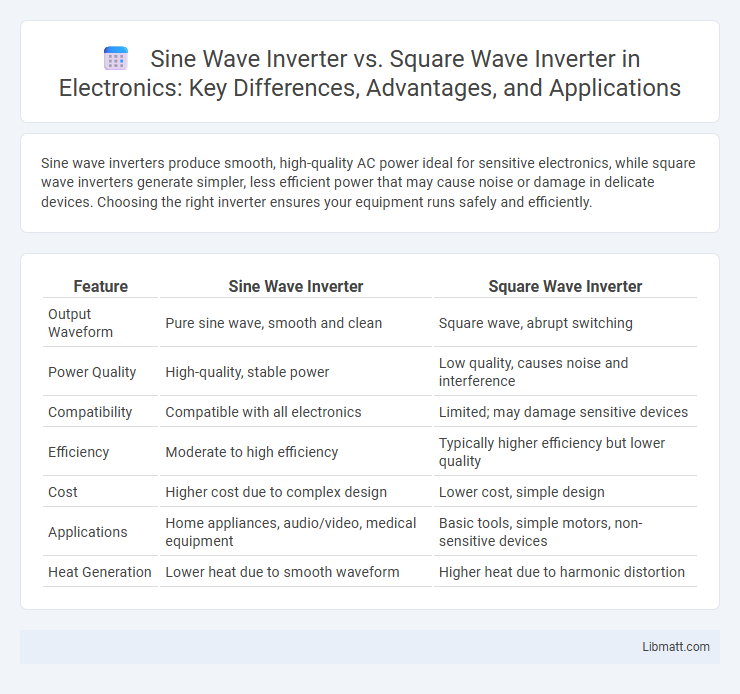Sine wave inverters produce smooth, high-quality AC power ideal for sensitive electronics, while square wave inverters generate simpler, less efficient power that may cause noise or damage in delicate devices. Choosing the right inverter ensures your equipment runs safely and efficiently.
Table of Comparison
| Feature | Sine Wave Inverter | Square Wave Inverter |
|---|---|---|
| Output Waveform | Pure sine wave, smooth and clean | Square wave, abrupt switching |
| Power Quality | High-quality, stable power | Low quality, causes noise and interference |
| Compatibility | Compatible with all electronics | Limited; may damage sensitive devices |
| Efficiency | Moderate to high efficiency | Typically higher efficiency but lower quality |
| Cost | Higher cost due to complex design | Lower cost, simple design |
| Applications | Home appliances, audio/video, medical equipment | Basic tools, simple motors, non-sensitive devices |
| Heat Generation | Lower heat due to smooth waveform | Higher heat due to harmonic distortion |
Introduction to Inverters
Inverters convert DC power to AC power, with sine wave inverters producing smooth, natural waveforms ideal for sensitive electronics and household appliances. Square wave inverters output a simpler, stepped waveform suitable for basic tools and devices but may cause noise or reduced efficiency in complex equipment. Choosing the right inverter depends on Your power needs and the type of devices you intend to run.
What is a Sine Wave Inverter?
A sine wave inverter converts direct current (DC) into smooth, continuous alternating current (AC) that closely mimics the natural sine wave produced by utility grids, ensuring compatibility with sensitive electronics. Its output reduces electrical noise and heat buildup, providing efficient power for devices such as computers, medical equipment, and audio systems. Your choice of a sine wave inverter enhances performance and longevity for appliances requiring stable and clean energy.
What is a Square Wave Inverter?
A Square Wave Inverter converts direct current (DC) into an alternating current (AC) voltage that rapidly switches between high and low levels, producing a non-sinusoidal waveform resembling a square shape. This type of inverter is simpler in design and generally less expensive but generates more harmonic distortion and electrical noise compared to sine wave inverters. Square wave inverters are suitable for powering simple resistive loads but are inefficient and potentially damaging when used with sensitive electronic devices or inductive loads.
Key Differences Between Sine Wave and Square Wave Inverters
Sine wave inverters produce a smooth, continuous waveform closely matching the utility grid, making them ideal for sensitive electronics and appliances requiring stable power. Square wave inverters generate a simpler, stepped waveform that can cause inefficiency or noise in devices, limiting their use to basic tools and equipment. Your choice depends on power quality needs, with sine wave inverters offering superior compatibility and performance for modern electronics.
Efficiency Comparison
Sine wave inverters generally offer higher energy conversion efficiency compared to square wave inverters, often exceeding 90%, due to their ability to produce smooth, continuous waveforms that reduce power loss in connected devices. Square wave inverters tend to have lower efficiency, typically around 70-80%, as their abrupt waveform transitions create greater harmonic distortion and heat dissipation. This efficiency gap impacts overall system performance, making sine wave inverters more suitable for sensitive electronics and long-term energy savings.
Applications and Suitability
Sine wave inverters are ideal for sensitive electronics, medical equipment, and household appliances requiring clean, stable power due to their smooth and consistent waveform. Square wave inverters are more suitable for simple tools and devices with resistive loads such as incandescent lighting and basic motors where waveform purity is less critical. Selecting the right inverter type depends on the specific power quality requirements and the sensitivity of the connected equipment.
Advantages of Sine Wave Inverters
Sine wave inverters provide a clean, smooth power output that closely mimics the utility grid, ensuring compatibility with sensitive electronics and reducing the risk of damage or interference. Their efficiency in powering devices like medical equipment, audio systems, and variable speed motors enhances performance and extends appliance lifespan. You benefit from quieter operation and improved energy efficiency, making sine wave inverters the preferred choice for reliable and high-quality power conversion.
Advantages of Square Wave Inverters
Square wave inverters offer a simpler design, which makes them more cost-effective and easier to manufacture compared to sine wave inverters. Their efficiency in converting DC to AC power is higher in low-cost applications, particularly where the load does not require a pure sine wave, such as in resistive heating or simple motor applications. Square wave inverters are also robust and have fewer components, leading to reduced maintenance and higher durability in rugged environments.
Cost and Availability
Square wave inverters are generally more affordable and widely available compared to sine wave inverters due to their simpler design and manufacturing process. Sine wave inverters, while more expensive, provide cleaner and more reliable power suitable for sensitive electronics and are increasingly accessible as technology advances. The choice between the two often depends on budget constraints and the specific power quality requirements of the application.
Conclusion: Choosing the Right Inverter
Choosing the right inverter depends on the application and power quality requirements. Sine wave inverters provide clean, stable power ideal for sensitive electronics and appliances, while square wave inverters are cost-effective for simple, less sensitive devices. Your decision should balance efficiency, compatibility, and budget to ensure optimal performance and longevity.
Sine wave inverter vs Square wave inverter Infographic

 libmatt.com
libmatt.com